Strategic Management Report: Strategic Analysis of Nestle in Sri Lanka
VerifiedAdded on 2023/06/09
|22
|4878
|64
Report
AI Summary
This report offers a comprehensive strategic management analysis of Nestle in Sri Lanka. It begins with an executive summary and table of contents, providing an overview of Nestle's operations within the food and beverage industry. The report delves into Nestle's vision and mission, emphasizing its commitment to providing high-quality, nutritious products. It applies Porter's value chain to analyze the company's primary and support activities, including inbound and outbound logistics, marketing, and human resource management. A PESTEL analysis examines the political, economic, social, technological, environmental, and legal factors influencing Nestle's business. Furthermore, the report assesses the competitive landscape using Porter's five forces, considering threats from new entrants, substitute products, and the bargaining power of suppliers and customers. The analysis highlights Nestle's strategies for maintaining a sustainable position and achieving competitive advantage, including creating shared value, managing innovation, and implementing effective international and distribution strategies. The report concludes by emphasizing Nestle's success in navigating market challenges and its commitment to corporate governance and ethical business practices. The report is a valuable resource for understanding the strategic decisions that have contributed to Nestle's success in the Sri Lankan market.
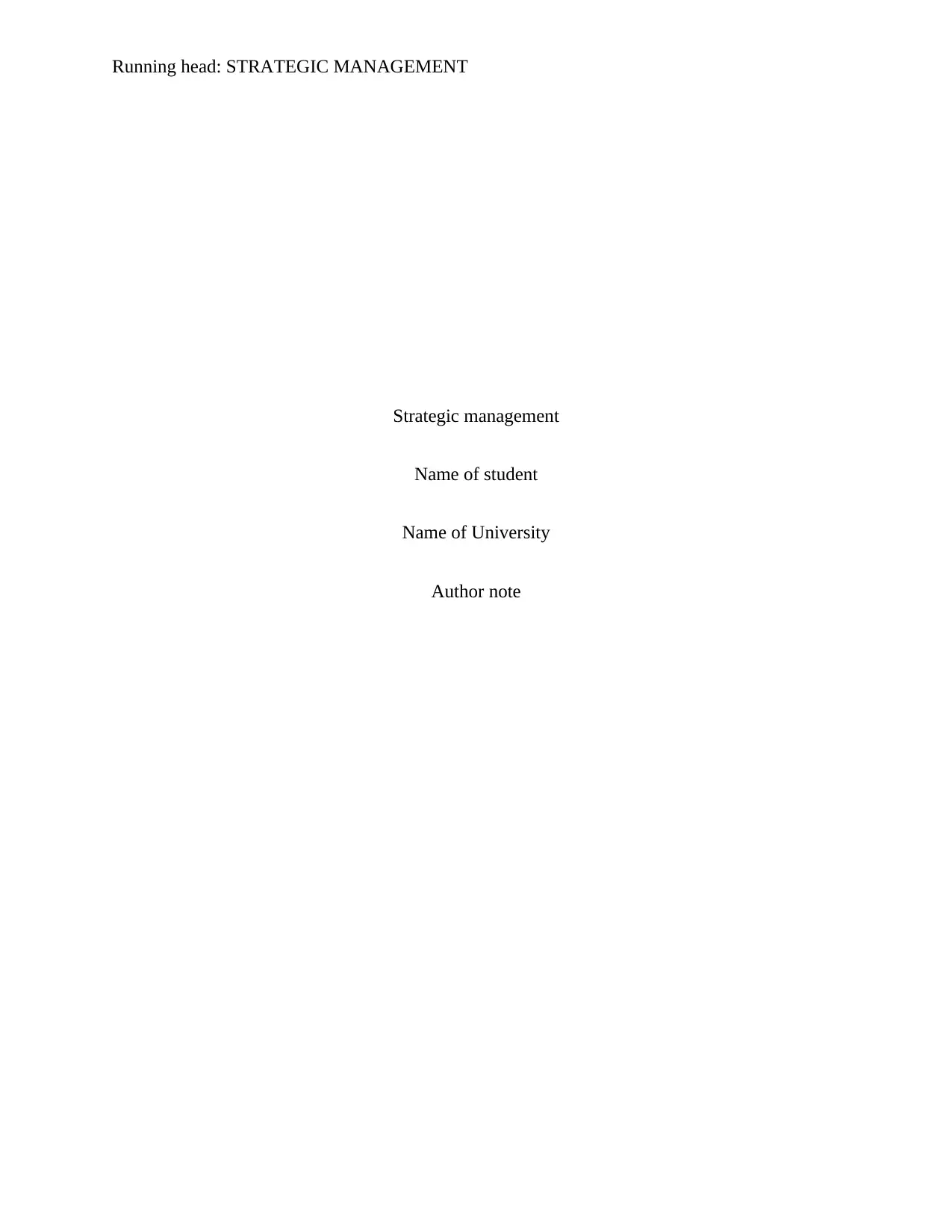
Running head: STRATEGIC MANAGEMENT
Strategic management
Name of student
Name of University
Author note
Strategic management
Name of student
Name of University
Author note
Paraphrase This Document
Need a fresh take? Get an instant paraphrase of this document with our AI Paraphraser
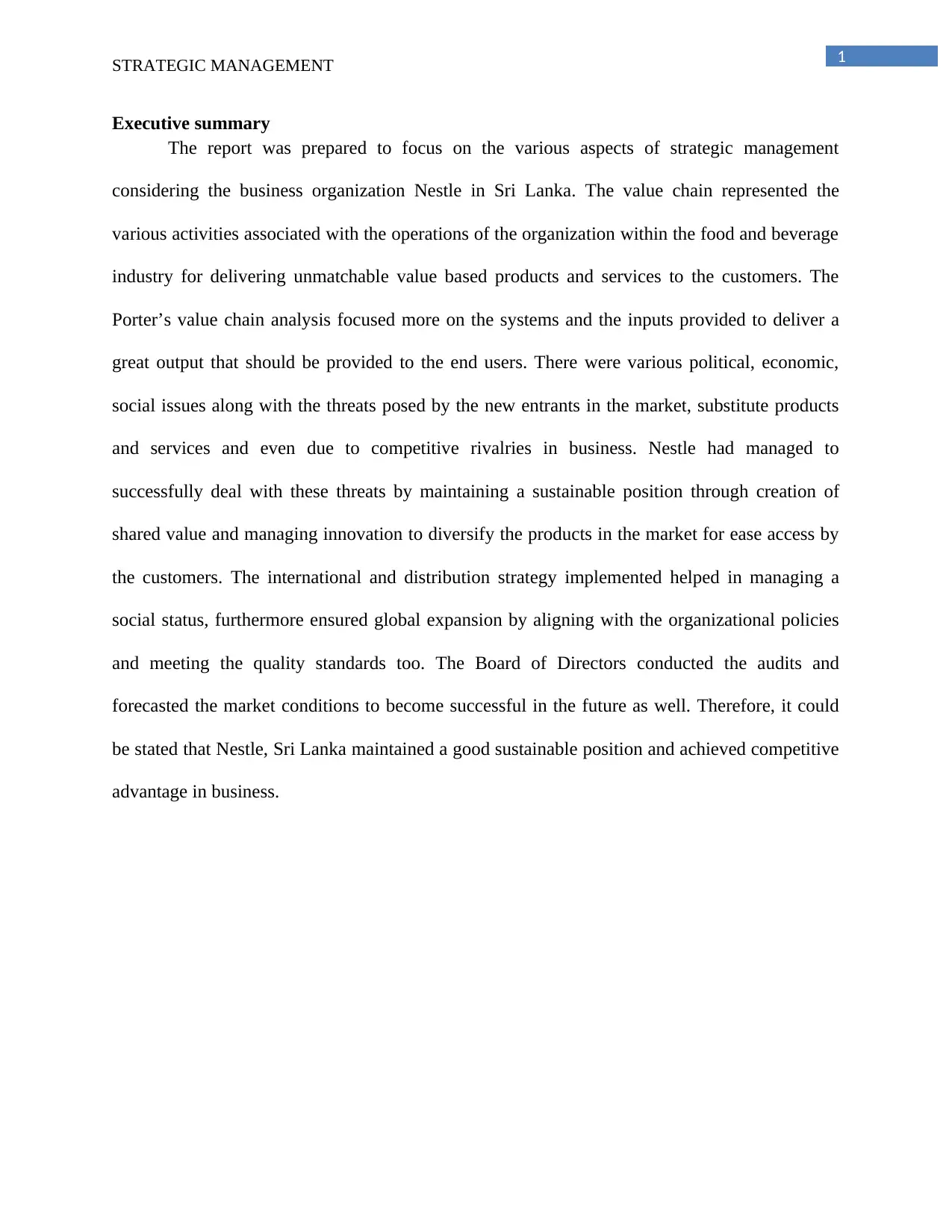
1
STRATEGIC MANAGEMENT
Executive summary
The report was prepared to focus on the various aspects of strategic management
considering the business organization Nestle in Sri Lanka. The value chain represented the
various activities associated with the operations of the organization within the food and beverage
industry for delivering unmatchable value based products and services to the customers. The
Porter’s value chain analysis focused more on the systems and the inputs provided to deliver a
great output that should be provided to the end users. There were various political, economic,
social issues along with the threats posed by the new entrants in the market, substitute products
and services and even due to competitive rivalries in business. Nestle had managed to
successfully deal with these threats by maintaining a sustainable position through creation of
shared value and managing innovation to diversify the products in the market for ease access by
the customers. The international and distribution strategy implemented helped in managing a
social status, furthermore ensured global expansion by aligning with the organizational policies
and meeting the quality standards too. The Board of Directors conducted the audits and
forecasted the market conditions to become successful in the future as well. Therefore, it could
be stated that Nestle, Sri Lanka maintained a good sustainable position and achieved competitive
advantage in business.
STRATEGIC MANAGEMENT
Executive summary
The report was prepared to focus on the various aspects of strategic management
considering the business organization Nestle in Sri Lanka. The value chain represented the
various activities associated with the operations of the organization within the food and beverage
industry for delivering unmatchable value based products and services to the customers. The
Porter’s value chain analysis focused more on the systems and the inputs provided to deliver a
great output that should be provided to the end users. There were various political, economic,
social issues along with the threats posed by the new entrants in the market, substitute products
and services and even due to competitive rivalries in business. Nestle had managed to
successfully deal with these threats by maintaining a sustainable position through creation of
shared value and managing innovation to diversify the products in the market for ease access by
the customers. The international and distribution strategy implemented helped in managing a
social status, furthermore ensured global expansion by aligning with the organizational policies
and meeting the quality standards too. The Board of Directors conducted the audits and
forecasted the market conditions to become successful in the future as well. Therefore, it could
be stated that Nestle, Sri Lanka maintained a good sustainable position and achieved competitive
advantage in business.
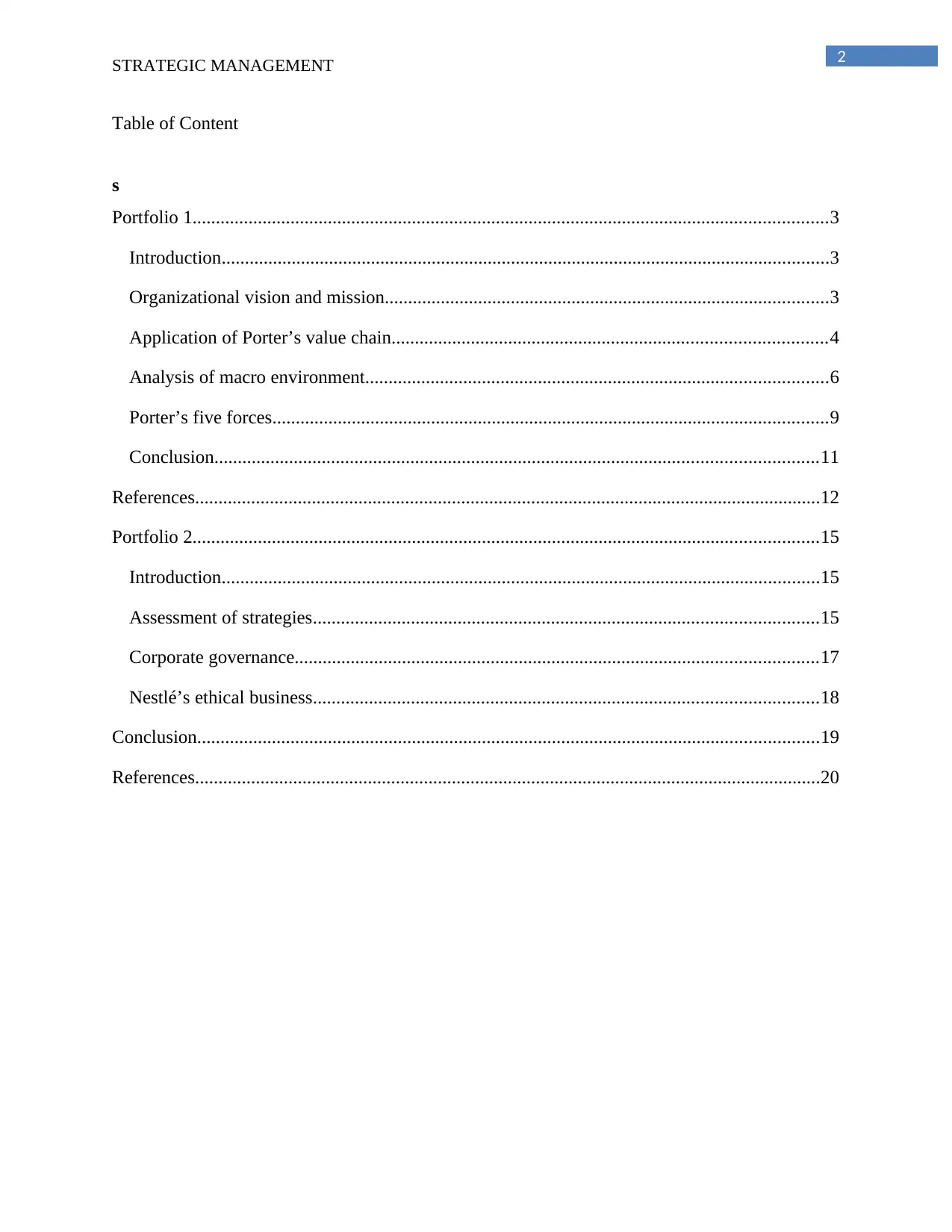
2
STRATEGIC MANAGEMENT
Table of Content
s
Portfolio 1........................................................................................................................................3
Introduction..................................................................................................................................3
Organizational vision and mission...............................................................................................3
Application of Porter’s value chain.............................................................................................4
Analysis of macro environment...................................................................................................6
Porter’s five forces.......................................................................................................................9
Conclusion.................................................................................................................................11
References......................................................................................................................................12
Portfolio 2......................................................................................................................................15
Introduction................................................................................................................................15
Assessment of strategies............................................................................................................15
Corporate governance................................................................................................................17
Nestlé’s ethical business............................................................................................................18
Conclusion.....................................................................................................................................19
References......................................................................................................................................20
STRATEGIC MANAGEMENT
Table of Content
s
Portfolio 1........................................................................................................................................3
Introduction..................................................................................................................................3
Organizational vision and mission...............................................................................................3
Application of Porter’s value chain.............................................................................................4
Analysis of macro environment...................................................................................................6
Porter’s five forces.......................................................................................................................9
Conclusion.................................................................................................................................11
References......................................................................................................................................12
Portfolio 2......................................................................................................................................15
Introduction................................................................................................................................15
Assessment of strategies............................................................................................................15
Corporate governance................................................................................................................17
Nestlé’s ethical business............................................................................................................18
Conclusion.....................................................................................................................................19
References......................................................................................................................................20
⊘ This is a preview!⊘
Do you want full access?
Subscribe today to unlock all pages.

Trusted by 1+ million students worldwide
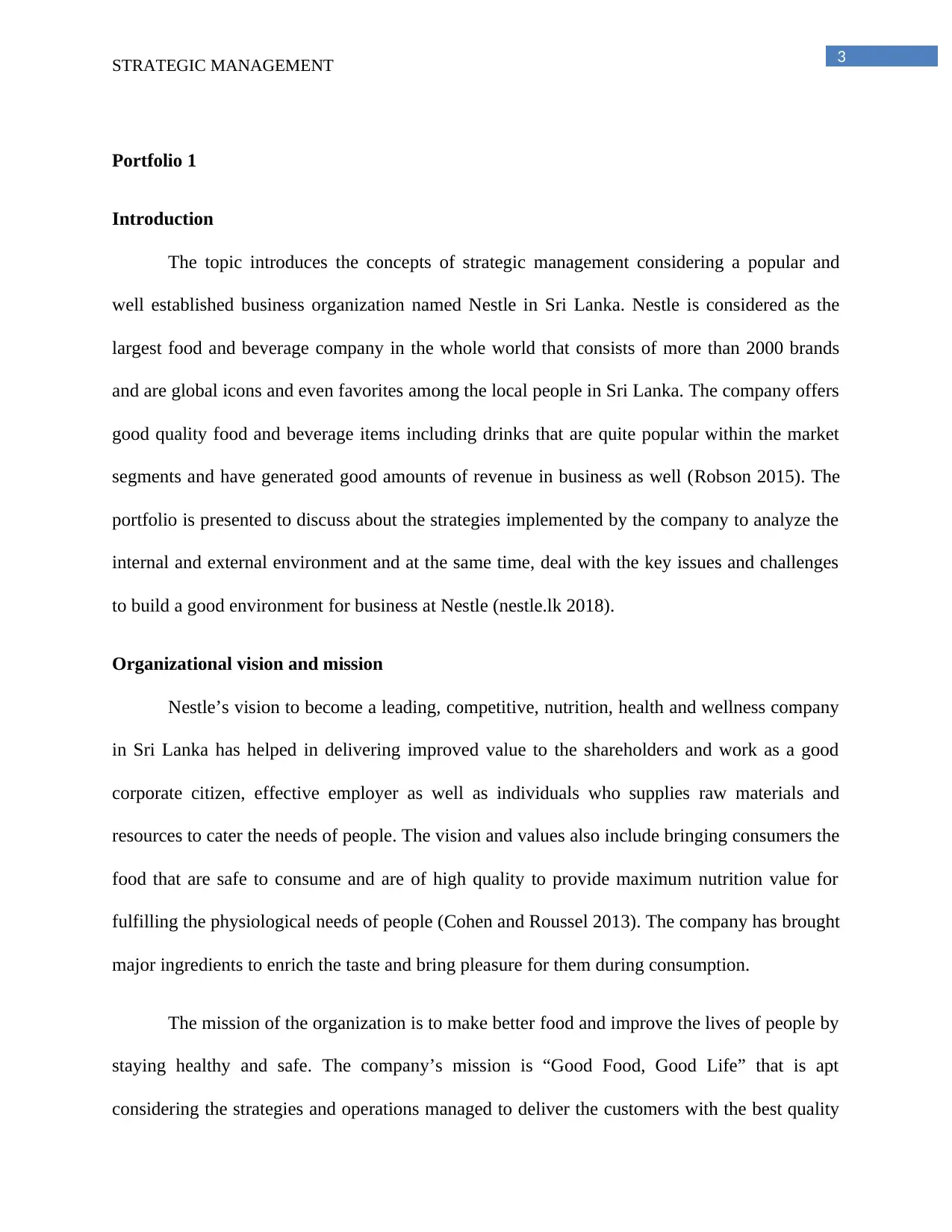
3
STRATEGIC MANAGEMENT
Portfolio 1
Introduction
The topic introduces the concepts of strategic management considering a popular and
well established business organization named Nestle in Sri Lanka. Nestle is considered as the
largest food and beverage company in the whole world that consists of more than 2000 brands
and are global icons and even favorites among the local people in Sri Lanka. The company offers
good quality food and beverage items including drinks that are quite popular within the market
segments and have generated good amounts of revenue in business as well (Robson 2015). The
portfolio is presented to discuss about the strategies implemented by the company to analyze the
internal and external environment and at the same time, deal with the key issues and challenges
to build a good environment for business at Nestle (nestle.lk 2018).
Organizational vision and mission
Nestle’s vision to become a leading, competitive, nutrition, health and wellness company
in Sri Lanka has helped in delivering improved value to the shareholders and work as a good
corporate citizen, effective employer as well as individuals who supplies raw materials and
resources to cater the needs of people. The vision and values also include bringing consumers the
food that are safe to consume and are of high quality to provide maximum nutrition value for
fulfilling the physiological needs of people (Cohen and Roussel 2013). The company has brought
major ingredients to enrich the taste and bring pleasure for them during consumption.
The mission of the organization is to make better food and improve the lives of people by
staying healthy and safe. The company’s mission is “Good Food, Good Life” that is apt
considering the strategies and operations managed to deliver the customers with the best quality
STRATEGIC MANAGEMENT
Portfolio 1
Introduction
The topic introduces the concepts of strategic management considering a popular and
well established business organization named Nestle in Sri Lanka. Nestle is considered as the
largest food and beverage company in the whole world that consists of more than 2000 brands
and are global icons and even favorites among the local people in Sri Lanka. The company offers
good quality food and beverage items including drinks that are quite popular within the market
segments and have generated good amounts of revenue in business as well (Robson 2015). The
portfolio is presented to discuss about the strategies implemented by the company to analyze the
internal and external environment and at the same time, deal with the key issues and challenges
to build a good environment for business at Nestle (nestle.lk 2018).
Organizational vision and mission
Nestle’s vision to become a leading, competitive, nutrition, health and wellness company
in Sri Lanka has helped in delivering improved value to the shareholders and work as a good
corporate citizen, effective employer as well as individuals who supplies raw materials and
resources to cater the needs of people. The vision and values also include bringing consumers the
food that are safe to consume and are of high quality to provide maximum nutrition value for
fulfilling the physiological needs of people (Cohen and Roussel 2013). The company has brought
major ingredients to enrich the taste and bring pleasure for them during consumption.
The mission of the organization is to make better food and improve the lives of people by
staying healthy and safe. The company’s mission is “Good Food, Good Life” that is apt
considering the strategies and operations managed to deliver the customers with the best quality
Paraphrase This Document
Need a fresh take? Get an instant paraphrase of this document with our AI Paraphraser
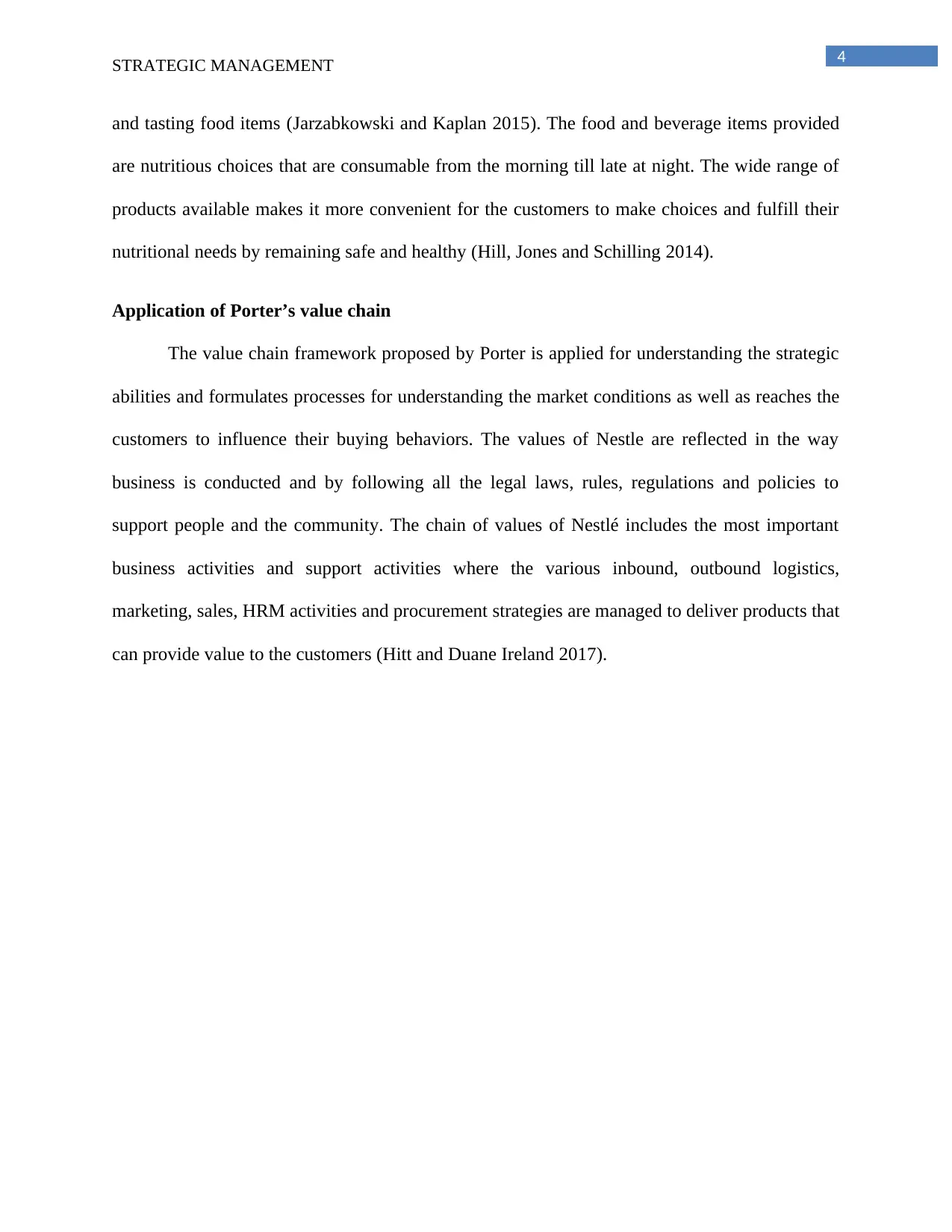
4
STRATEGIC MANAGEMENT
and tasting food items (Jarzabkowski and Kaplan 2015). The food and beverage items provided
are nutritious choices that are consumable from the morning till late at night. The wide range of
products available makes it more convenient for the customers to make choices and fulfill their
nutritional needs by remaining safe and healthy (Hill, Jones and Schilling 2014).
Application of Porter’s value chain
The value chain framework proposed by Porter is applied for understanding the strategic
abilities and formulates processes for understanding the market conditions as well as reaches the
customers to influence their buying behaviors. The values of Nestle are reflected in the way
business is conducted and by following all the legal laws, rules, regulations and policies to
support people and the community. The chain of values of Nestlé includes the most important
business activities and support activities where the various inbound, outbound logistics,
marketing, sales, HRM activities and procurement strategies are managed to deliver products that
can provide value to the customers (Hitt and Duane Ireland 2017).
STRATEGIC MANAGEMENT
and tasting food items (Jarzabkowski and Kaplan 2015). The food and beverage items provided
are nutritious choices that are consumable from the morning till late at night. The wide range of
products available makes it more convenient for the customers to make choices and fulfill their
nutritional needs by remaining safe and healthy (Hill, Jones and Schilling 2014).
Application of Porter’s value chain
The value chain framework proposed by Porter is applied for understanding the strategic
abilities and formulates processes for understanding the market conditions as well as reaches the
customers to influence their buying behaviors. The values of Nestle are reflected in the way
business is conducted and by following all the legal laws, rules, regulations and policies to
support people and the community. The chain of values of Nestlé includes the most important
business activities and support activities where the various inbound, outbound logistics,
marketing, sales, HRM activities and procurement strategies are managed to deliver products that
can provide value to the customers (Hitt and Duane Ireland 2017).
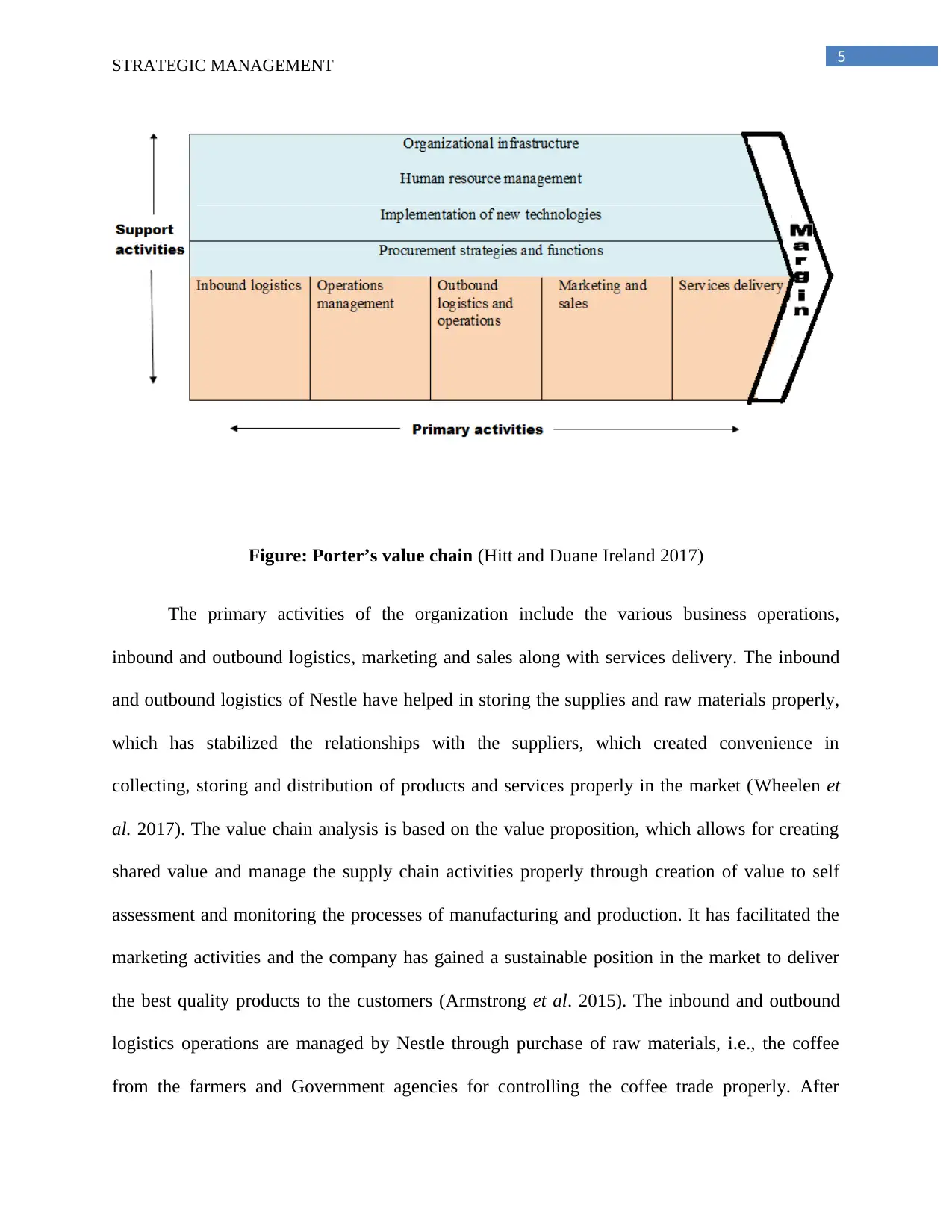
5
STRATEGIC MANAGEMENT
Figure: Porter’s value chain (Hitt and Duane Ireland 2017)
The primary activities of the organization include the various business operations,
inbound and outbound logistics, marketing and sales along with services delivery. The inbound
and outbound logistics of Nestle have helped in storing the supplies and raw materials properly,
which has stabilized the relationships with the suppliers, which created convenience in
collecting, storing and distribution of products and services properly in the market (Wheelen et
al. 2017). The value chain analysis is based on the value proposition, which allows for creating
shared value and manage the supply chain activities properly through creation of value to self
assessment and monitoring the processes of manufacturing and production. It has facilitated the
marketing activities and the company has gained a sustainable position in the market to deliver
the best quality products to the customers (Armstrong et al. 2015). The inbound and outbound
logistics operations are managed by Nestle through purchase of raw materials, i.e., the coffee
from the farmers and Government agencies for controlling the coffee trade properly. After
STRATEGIC MANAGEMENT
Figure: Porter’s value chain (Hitt and Duane Ireland 2017)
The primary activities of the organization include the various business operations,
inbound and outbound logistics, marketing and sales along with services delivery. The inbound
and outbound logistics of Nestle have helped in storing the supplies and raw materials properly,
which has stabilized the relationships with the suppliers, which created convenience in
collecting, storing and distribution of products and services properly in the market (Wheelen et
al. 2017). The value chain analysis is based on the value proposition, which allows for creating
shared value and manage the supply chain activities properly through creation of value to self
assessment and monitoring the processes of manufacturing and production. It has facilitated the
marketing activities and the company has gained a sustainable position in the market to deliver
the best quality products to the customers (Armstrong et al. 2015). The inbound and outbound
logistics operations are managed by Nestle through purchase of raw materials, i.e., the coffee
from the farmers and Government agencies for controlling the coffee trade properly. After
⊘ This is a preview!⊘
Do you want full access?
Subscribe today to unlock all pages.

Trusted by 1+ million students worldwide
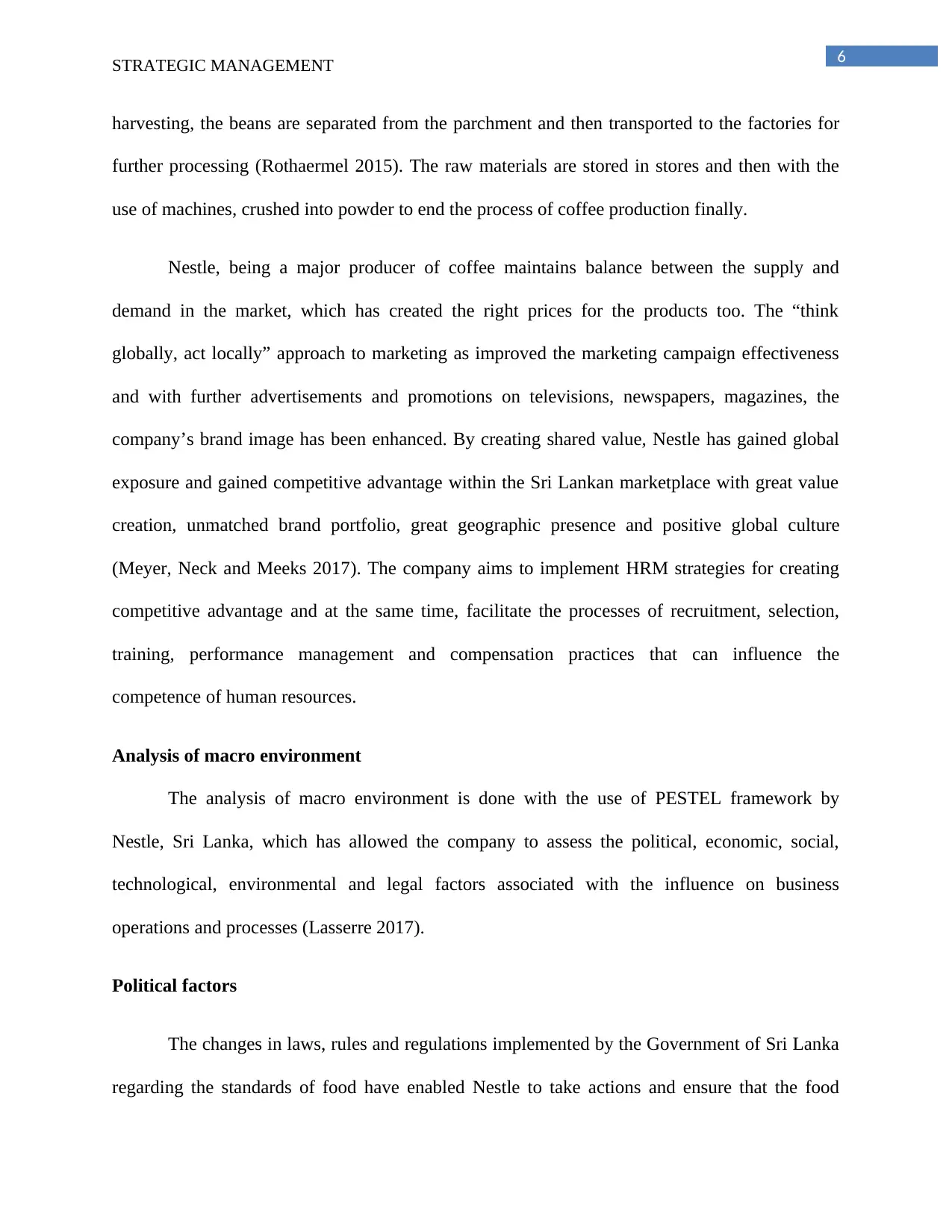
6
STRATEGIC MANAGEMENT
harvesting, the beans are separated from the parchment and then transported to the factories for
further processing (Rothaermel 2015). The raw materials are stored in stores and then with the
use of machines, crushed into powder to end the process of coffee production finally.
Nestle, being a major producer of coffee maintains balance between the supply and
demand in the market, which has created the right prices for the products too. The “think
globally, act locally” approach to marketing as improved the marketing campaign effectiveness
and with further advertisements and promotions on televisions, newspapers, magazines, the
company’s brand image has been enhanced. By creating shared value, Nestle has gained global
exposure and gained competitive advantage within the Sri Lankan marketplace with great value
creation, unmatched brand portfolio, great geographic presence and positive global culture
(Meyer, Neck and Meeks 2017). The company aims to implement HRM strategies for creating
competitive advantage and at the same time, facilitate the processes of recruitment, selection,
training, performance management and compensation practices that can influence the
competence of human resources.
Analysis of macro environment
The analysis of macro environment is done with the use of PESTEL framework by
Nestle, Sri Lanka, which has allowed the company to assess the political, economic, social,
technological, environmental and legal factors associated with the influence on business
operations and processes (Lasserre 2017).
Political factors
The changes in laws, rules and regulations implemented by the Government of Sri Lanka
regarding the standards of food have enabled Nestle to take actions and ensure that the food
STRATEGIC MANAGEMENT
harvesting, the beans are separated from the parchment and then transported to the factories for
further processing (Rothaermel 2015). The raw materials are stored in stores and then with the
use of machines, crushed into powder to end the process of coffee production finally.
Nestle, being a major producer of coffee maintains balance between the supply and
demand in the market, which has created the right prices for the products too. The “think
globally, act locally” approach to marketing as improved the marketing campaign effectiveness
and with further advertisements and promotions on televisions, newspapers, magazines, the
company’s brand image has been enhanced. By creating shared value, Nestle has gained global
exposure and gained competitive advantage within the Sri Lankan marketplace with great value
creation, unmatched brand portfolio, great geographic presence and positive global culture
(Meyer, Neck and Meeks 2017). The company aims to implement HRM strategies for creating
competitive advantage and at the same time, facilitate the processes of recruitment, selection,
training, performance management and compensation practices that can influence the
competence of human resources.
Analysis of macro environment
The analysis of macro environment is done with the use of PESTEL framework by
Nestle, Sri Lanka, which has allowed the company to assess the political, economic, social,
technological, environmental and legal factors associated with the influence on business
operations and processes (Lasserre 2017).
Political factors
The changes in laws, rules and regulations implemented by the Government of Sri Lanka
regarding the standards of food have enabled Nestle to take actions and ensure that the food
Paraphrase This Document
Need a fresh take? Get an instant paraphrase of this document with our AI Paraphraser
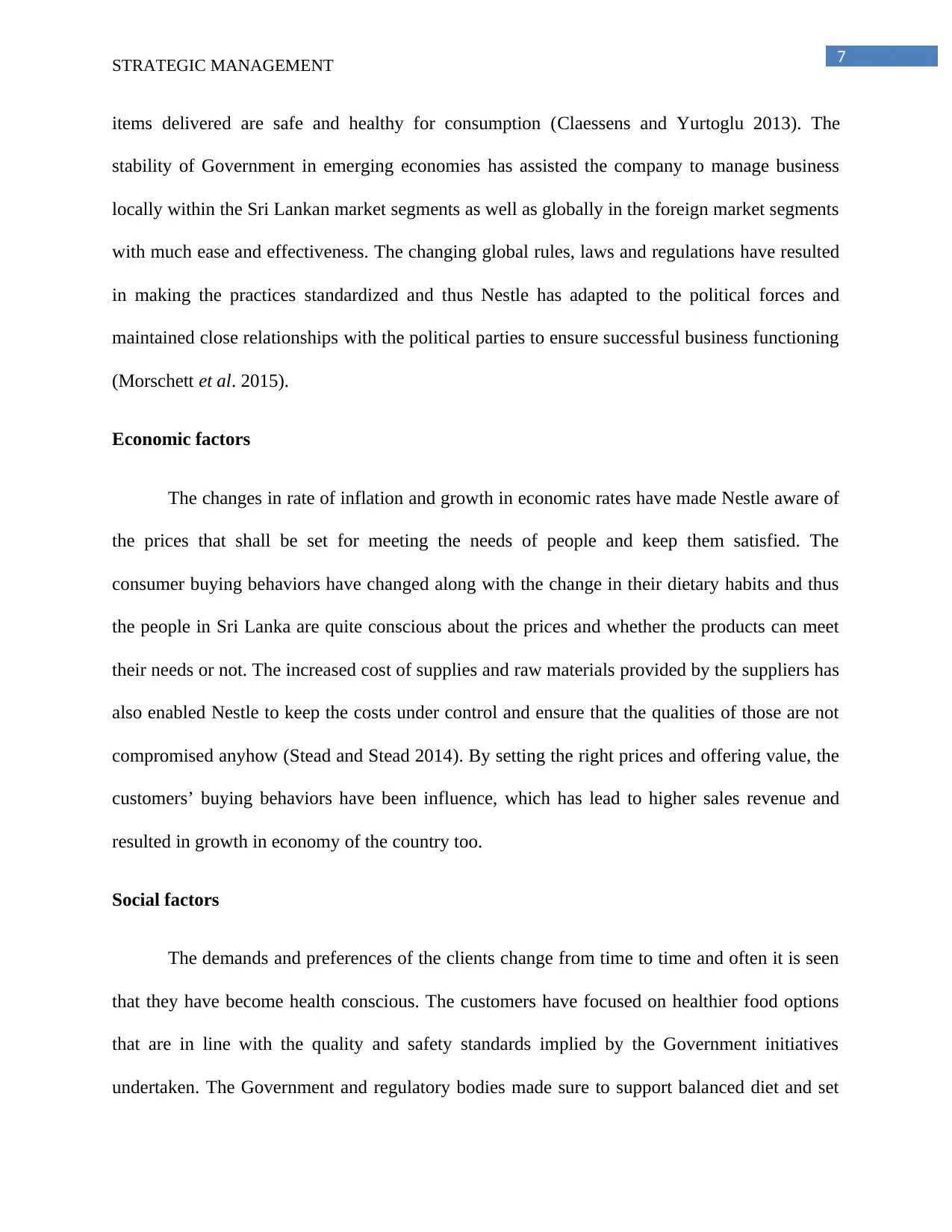
7
STRATEGIC MANAGEMENT
items delivered are safe and healthy for consumption (Claessens and Yurtoglu 2013). The
stability of Government in emerging economies has assisted the company to manage business
locally within the Sri Lankan market segments as well as globally in the foreign market segments
with much ease and effectiveness. The changing global rules, laws and regulations have resulted
in making the practices standardized and thus Nestle has adapted to the political forces and
maintained close relationships with the political parties to ensure successful business functioning
(Morschett et al. 2015).
Economic factors
The changes in rate of inflation and growth in economic rates have made Nestle aware of
the prices that shall be set for meeting the needs of people and keep them satisfied. The
consumer buying behaviors have changed along with the change in their dietary habits and thus
the people in Sri Lanka are quite conscious about the prices and whether the products can meet
their needs or not. The increased cost of supplies and raw materials provided by the suppliers has
also enabled Nestle to keep the costs under control and ensure that the qualities of those are not
compromised anyhow (Stead and Stead 2014). By setting the right prices and offering value, the
customers’ buying behaviors have been influence, which has lead to higher sales revenue and
resulted in growth in economy of the country too.
Social factors
The demands and preferences of the clients change from time to time and often it is seen
that they have become health conscious. The customers have focused on healthier food options
that are in line with the quality and safety standards implied by the Government initiatives
undertaken. The Government and regulatory bodies made sure to support balanced diet and set
STRATEGIC MANAGEMENT
items delivered are safe and healthy for consumption (Claessens and Yurtoglu 2013). The
stability of Government in emerging economies has assisted the company to manage business
locally within the Sri Lankan market segments as well as globally in the foreign market segments
with much ease and effectiveness. The changing global rules, laws and regulations have resulted
in making the practices standardized and thus Nestle has adapted to the political forces and
maintained close relationships with the political parties to ensure successful business functioning
(Morschett et al. 2015).
Economic factors
The changes in rate of inflation and growth in economic rates have made Nestle aware of
the prices that shall be set for meeting the needs of people and keep them satisfied. The
consumer buying behaviors have changed along with the change in their dietary habits and thus
the people in Sri Lanka are quite conscious about the prices and whether the products can meet
their needs or not. The increased cost of supplies and raw materials provided by the suppliers has
also enabled Nestle to keep the costs under control and ensure that the qualities of those are not
compromised anyhow (Stead and Stead 2014). By setting the right prices and offering value, the
customers’ buying behaviors have been influence, which has lead to higher sales revenue and
resulted in growth in economy of the country too.
Social factors
The demands and preferences of the clients change from time to time and often it is seen
that they have become health conscious. The customers have focused on healthier food options
that are in line with the quality and safety standards implied by the Government initiatives
undertaken. The Government and regulatory bodies made sure to support balanced diet and set
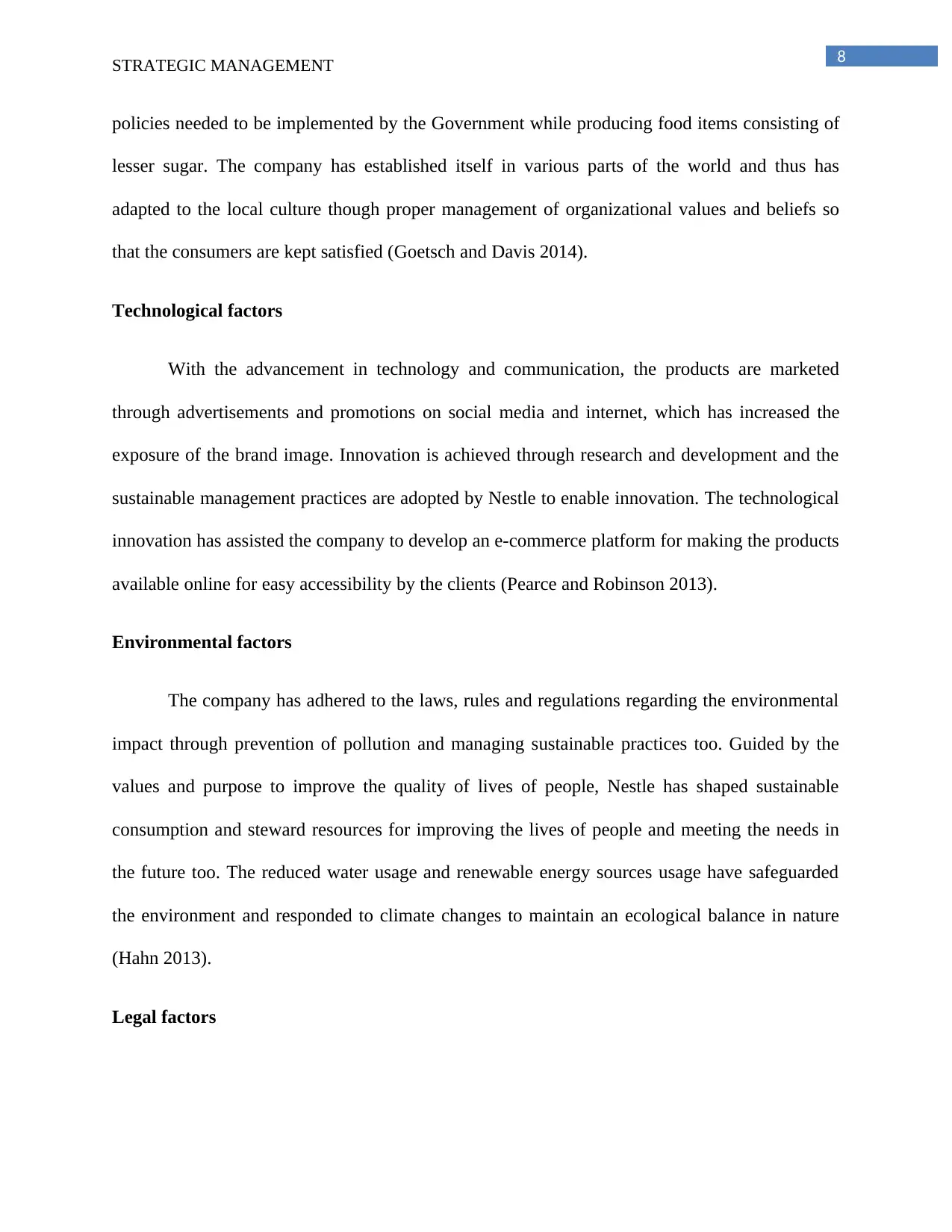
8
STRATEGIC MANAGEMENT
policies needed to be implemented by the Government while producing food items consisting of
lesser sugar. The company has established itself in various parts of the world and thus has
adapted to the local culture though proper management of organizational values and beliefs so
that the consumers are kept satisfied (Goetsch and Davis 2014).
Technological factors
With the advancement in technology and communication, the products are marketed
through advertisements and promotions on social media and internet, which has increased the
exposure of the brand image. Innovation is achieved through research and development and the
sustainable management practices are adopted by Nestle to enable innovation. The technological
innovation has assisted the company to develop an e-commerce platform for making the products
available online for easy accessibility by the clients (Pearce and Robinson 2013).
Environmental factors
The company has adhered to the laws, rules and regulations regarding the environmental
impact through prevention of pollution and managing sustainable practices too. Guided by the
values and purpose to improve the quality of lives of people, Nestle has shaped sustainable
consumption and steward resources for improving the lives of people and meeting the needs in
the future too. The reduced water usage and renewable energy sources usage have safeguarded
the environment and responded to climate changes to maintain an ecological balance in nature
(Hahn 2013).
Legal factors
STRATEGIC MANAGEMENT
policies needed to be implemented by the Government while producing food items consisting of
lesser sugar. The company has established itself in various parts of the world and thus has
adapted to the local culture though proper management of organizational values and beliefs so
that the consumers are kept satisfied (Goetsch and Davis 2014).
Technological factors
With the advancement in technology and communication, the products are marketed
through advertisements and promotions on social media and internet, which has increased the
exposure of the brand image. Innovation is achieved through research and development and the
sustainable management practices are adopted by Nestle to enable innovation. The technological
innovation has assisted the company to develop an e-commerce platform for making the products
available online for easy accessibility by the clients (Pearce and Robinson 2013).
Environmental factors
The company has adhered to the laws, rules and regulations regarding the environmental
impact through prevention of pollution and managing sustainable practices too. Guided by the
values and purpose to improve the quality of lives of people, Nestle has shaped sustainable
consumption and steward resources for improving the lives of people and meeting the needs in
the future too. The reduced water usage and renewable energy sources usage have safeguarded
the environment and responded to climate changes to maintain an ecological balance in nature
(Hahn 2013).
Legal factors
⊘ This is a preview!⊘
Do you want full access?
Subscribe today to unlock all pages.

Trusted by 1+ million students worldwide
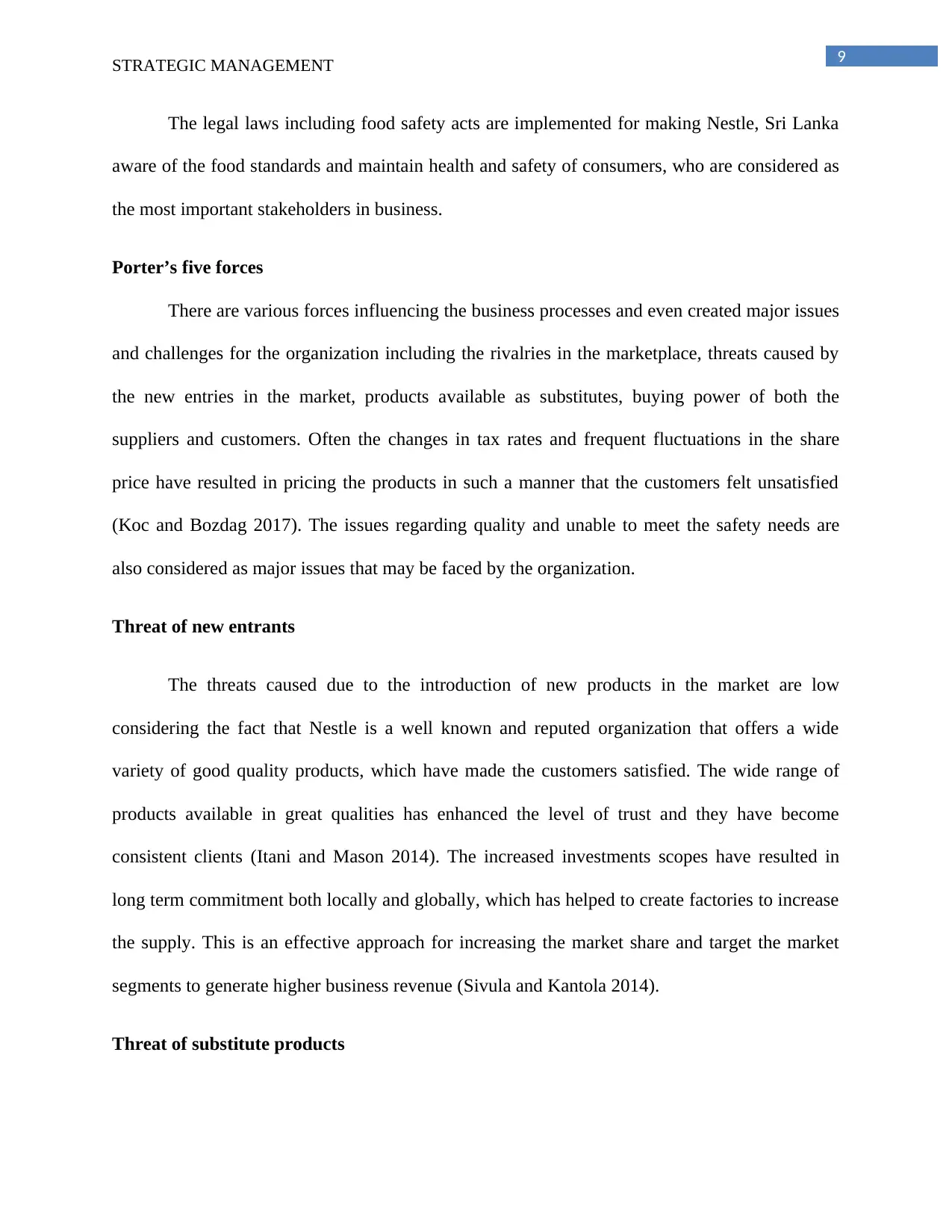
9
STRATEGIC MANAGEMENT
The legal laws including food safety acts are implemented for making Nestle, Sri Lanka
aware of the food standards and maintain health and safety of consumers, who are considered as
the most important stakeholders in business.
Porter’s five forces
There are various forces influencing the business processes and even created major issues
and challenges for the organization including the rivalries in the marketplace, threats caused by
the new entries in the market, products available as substitutes, buying power of both the
suppliers and customers. Often the changes in tax rates and frequent fluctuations in the share
price have resulted in pricing the products in such a manner that the customers felt unsatisfied
(Koc and Bozdag 2017). The issues regarding quality and unable to meet the safety needs are
also considered as major issues that may be faced by the organization.
Threat of new entrants
The threats caused due to the introduction of new products in the market are low
considering the fact that Nestle is a well known and reputed organization that offers a wide
variety of good quality products, which have made the customers satisfied. The wide range of
products available in great qualities has enhanced the level of trust and they have become
consistent clients (Itani and Mason 2014). The increased investments scopes have resulted in
long term commitment both locally and globally, which has helped to create factories to increase
the supply. This is an effective approach for increasing the market share and target the market
segments to generate higher business revenue (Sivula and Kantola 2014).
Threat of substitute products
STRATEGIC MANAGEMENT
The legal laws including food safety acts are implemented for making Nestle, Sri Lanka
aware of the food standards and maintain health and safety of consumers, who are considered as
the most important stakeholders in business.
Porter’s five forces
There are various forces influencing the business processes and even created major issues
and challenges for the organization including the rivalries in the marketplace, threats caused by
the new entries in the market, products available as substitutes, buying power of both the
suppliers and customers. Often the changes in tax rates and frequent fluctuations in the share
price have resulted in pricing the products in such a manner that the customers felt unsatisfied
(Koc and Bozdag 2017). The issues regarding quality and unable to meet the safety needs are
also considered as major issues that may be faced by the organization.
Threat of new entrants
The threats caused due to the introduction of new products in the market are low
considering the fact that Nestle is a well known and reputed organization that offers a wide
variety of good quality products, which have made the customers satisfied. The wide range of
products available in great qualities has enhanced the level of trust and they have become
consistent clients (Itani and Mason 2014). The increased investments scopes have resulted in
long term commitment both locally and globally, which has helped to create factories to increase
the supply. This is an effective approach for increasing the market share and target the market
segments to generate higher business revenue (Sivula and Kantola 2014).
Threat of substitute products
Paraphrase This Document
Need a fresh take? Get an instant paraphrase of this document with our AI Paraphraser
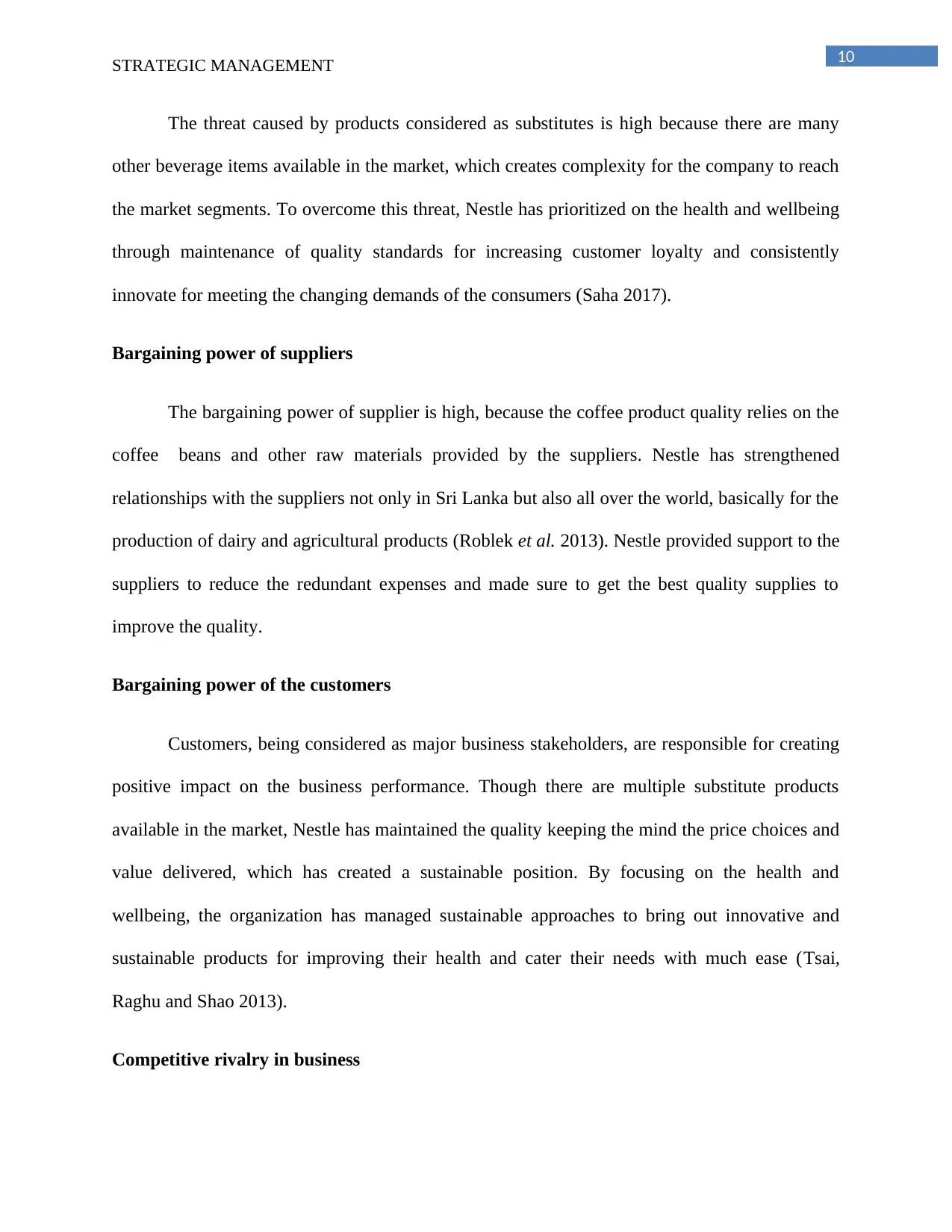
10
STRATEGIC MANAGEMENT
The threat caused by products considered as substitutes is high because there are many
other beverage items available in the market, which creates complexity for the company to reach
the market segments. To overcome this threat, Nestle has prioritized on the health and wellbeing
through maintenance of quality standards for increasing customer loyalty and consistently
innovate for meeting the changing demands of the consumers (Saha 2017).
Bargaining power of suppliers
The bargaining power of supplier is high, because the coffee product quality relies on the
coffee beans and other raw materials provided by the suppliers. Nestle has strengthened
relationships with the suppliers not only in Sri Lanka but also all over the world, basically for the
production of dairy and agricultural products (Roblek et al. 2013). Nestle provided support to the
suppliers to reduce the redundant expenses and made sure to get the best quality supplies to
improve the quality.
Bargaining power of the customers
Customers, being considered as major business stakeholders, are responsible for creating
positive impact on the business performance. Though there are multiple substitute products
available in the market, Nestle has maintained the quality keeping the mind the price choices and
value delivered, which has created a sustainable position. By focusing on the health and
wellbeing, the organization has managed sustainable approaches to bring out innovative and
sustainable products for improving their health and cater their needs with much ease (Tsai,
Raghu and Shao 2013).
Competitive rivalry in business
STRATEGIC MANAGEMENT
The threat caused by products considered as substitutes is high because there are many
other beverage items available in the market, which creates complexity for the company to reach
the market segments. To overcome this threat, Nestle has prioritized on the health and wellbeing
through maintenance of quality standards for increasing customer loyalty and consistently
innovate for meeting the changing demands of the consumers (Saha 2017).
Bargaining power of suppliers
The bargaining power of supplier is high, because the coffee product quality relies on the
coffee beans and other raw materials provided by the suppliers. Nestle has strengthened
relationships with the suppliers not only in Sri Lanka but also all over the world, basically for the
production of dairy and agricultural products (Roblek et al. 2013). Nestle provided support to the
suppliers to reduce the redundant expenses and made sure to get the best quality supplies to
improve the quality.
Bargaining power of the customers
Customers, being considered as major business stakeholders, are responsible for creating
positive impact on the business performance. Though there are multiple substitute products
available in the market, Nestle has maintained the quality keeping the mind the price choices and
value delivered, which has created a sustainable position. By focusing on the health and
wellbeing, the organization has managed sustainable approaches to bring out innovative and
sustainable products for improving their health and cater their needs with much ease (Tsai,
Raghu and Shao 2013).
Competitive rivalry in business
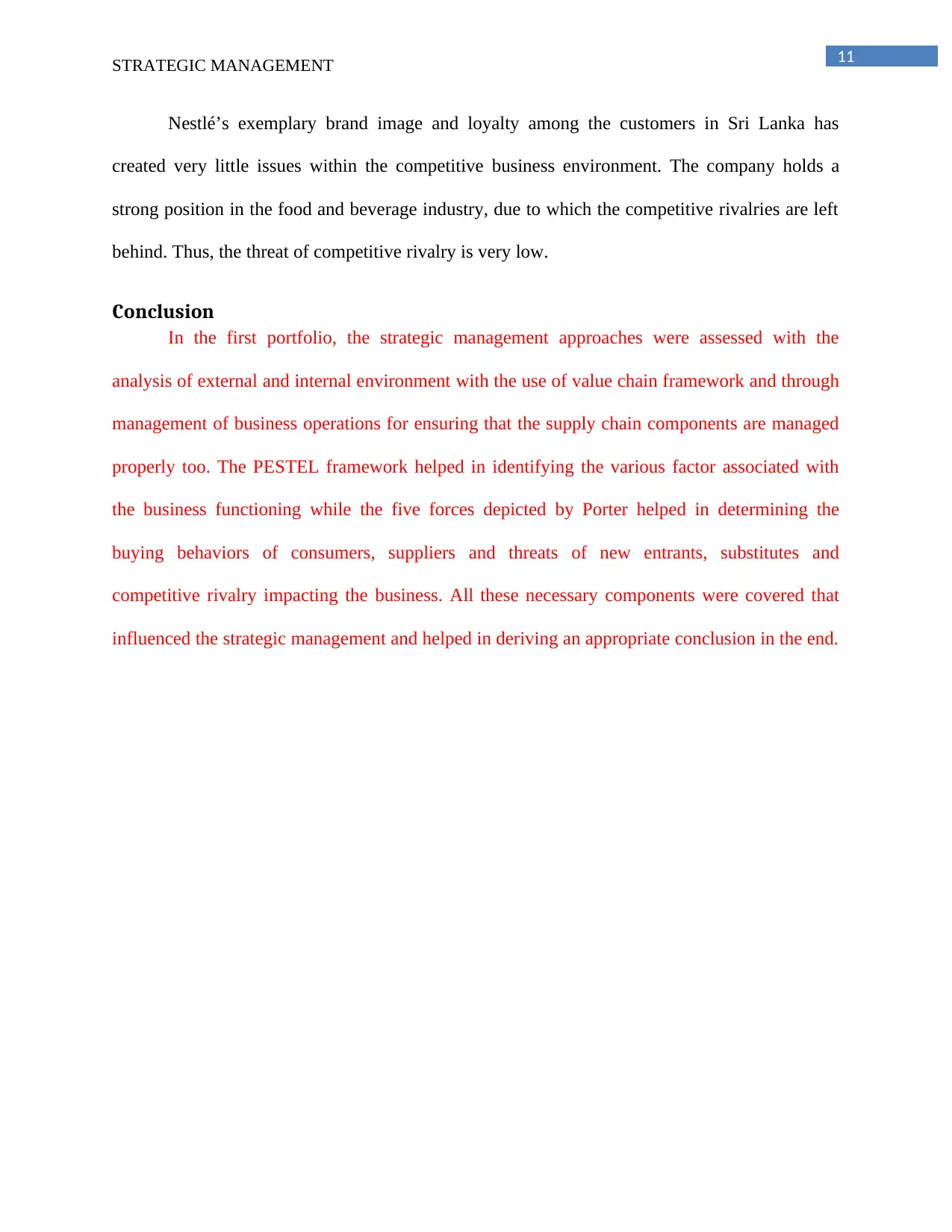
11
STRATEGIC MANAGEMENT
Nestlé’s exemplary brand image and loyalty among the customers in Sri Lanka has
created very little issues within the competitive business environment. The company holds a
strong position in the food and beverage industry, due to which the competitive rivalries are left
behind. Thus, the threat of competitive rivalry is very low.
Conclusion
In the first portfolio, the strategic management approaches were assessed with the
analysis of external and internal environment with the use of value chain framework and through
management of business operations for ensuring that the supply chain components are managed
properly too. The PESTEL framework helped in identifying the various factor associated with
the business functioning while the five forces depicted by Porter helped in determining the
buying behaviors of consumers, suppliers and threats of new entrants, substitutes and
competitive rivalry impacting the business. All these necessary components were covered that
influenced the strategic management and helped in deriving an appropriate conclusion in the end.
STRATEGIC MANAGEMENT
Nestlé’s exemplary brand image and loyalty among the customers in Sri Lanka has
created very little issues within the competitive business environment. The company holds a
strong position in the food and beverage industry, due to which the competitive rivalries are left
behind. Thus, the threat of competitive rivalry is very low.
Conclusion
In the first portfolio, the strategic management approaches were assessed with the
analysis of external and internal environment with the use of value chain framework and through
management of business operations for ensuring that the supply chain components are managed
properly too. The PESTEL framework helped in identifying the various factor associated with
the business functioning while the five forces depicted by Porter helped in determining the
buying behaviors of consumers, suppliers and threats of new entrants, substitutes and
competitive rivalry impacting the business. All these necessary components were covered that
influenced the strategic management and helped in deriving an appropriate conclusion in the end.
⊘ This is a preview!⊘
Do you want full access?
Subscribe today to unlock all pages.

Trusted by 1+ million students worldwide
1 out of 22
Related Documents
Your All-in-One AI-Powered Toolkit for Academic Success.
+13062052269
info@desklib.com
Available 24*7 on WhatsApp / Email
![[object Object]](/_next/static/media/star-bottom.7253800d.svg)
Unlock your academic potential
Copyright © 2020–2025 A2Z Services. All Rights Reserved. Developed and managed by ZUCOL.





